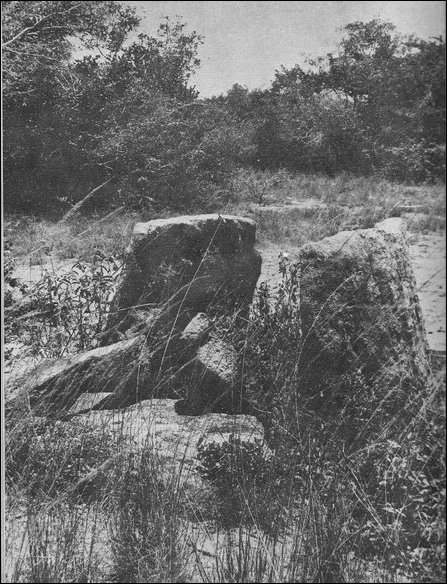Know the Etymology: 364
Place Name of the Day: Monday, 18 August 2014
Maavadi-vempu, Kurangkuppadai- vempu
மாவடி வெம்பு, குரங்குப்படை வெம்பு
Māvaṭi-vempu, Kuraṅkuppaṭai -vempuMaa+adi+vempu
Kurangku+padai+vempu
The parched or uncultivated wasteland in the locality of a mango tree
The parched or uncultivated wasteland having megalithic dolmens
| Vempu |
An arid or parched, unproductive tract of land (Eezham Tamil, Batticaloa dialect); Vempu: (verb) to be very hot, be dried with heat (Tamil, DED 5517); Vemmai: Heat, severity (Tamil, DED 5517); from the root Vea: To burn, be hot, be scorched (Tamil, DED 5517); Vem-parappu: Uncultivated waste (Tamil, MTL)
|
| Maa |
Mango (Tamil, Malayalam, Kannada, DED 4782)
|
| Adi |
A locative ending or case affix, meaning a locality; from Adi: foot, footprint, base, bottom, source, origin, (Tamil, DED 72)
|
| Kurangkuppadai |
also Kurangkup-paddadai: A term used in Tamil and Malayalam for megalithic dolmens. Myths arising from conflation associate the words Kurangku with monkeys, padai with troop and Paddadai with anvil stone or workshop. The probable etymology could be Kurampu, Ku’rangku: baulk, ridge, bund etc. (Tamil, DED 1772, inscriptions, SII, ii, 73); or Kurampu, Kurampai: Small hut, hovel, shed (Tamil, DED 1904); or Kurangku: to droop, wither, repose, diminish, to be lowered etc., implying death and burial in this context (Tamil, DED 1767, Thivaakaram, 9: 29); Padai: Bed, layer, stratum (Tamil, DED 3852); Pa’l’lip-padai: Burial monument (Tamil, inscriptions, SII, viii, 529)
|
Vempu is an Eezham Tamil toponymic term, peculiar to the Eastern Province. It is noticed in all the three districts of the province, Trincomalee, Batticaloa and Ampaa’rai.
Vempu is an uncultivated patch of land, usually parched and barren.
The word comes from the Tamil/ Dravidian verb root Vea, meaning to burn, be hot, be scorched etc. (DED 5517), and related derivatives are Vempu, which as a verb meaning to be parched or dried by heat (Changkam Tamil usage, DED 5571) and Vemmai, which as a noun meaning heat or severity (DED 5571).
* * *Usage of Vempu in descriptions of parched land in Changkam literature:
“Veyil veettiruntha vempu alai arugn churam” (Natti’nai 84: 9)
“வெயில் வீற்றிருந்த வெம்பு அலை அருஞ் சுரம்” (நற்றிணை 84: 9)
The arid tract where the sun presides over and scorching heat roams
“Paithu a'ra vempiya kal poru parappu” (Aka:naanoo'ru 185: 8)
“பைது அற வெம்பிய கல் பொரு பரப்பு” (அகநானூறு 185: 8)
The greenness-lost, scorched expanse of pricking stones
* * *Kurangkup-padai and Kurangkup-paddadai are traditional terms used in some parts of Tamil Nadu and Kerala to refer to one of the types of megalithic burial monuments. The current archaeological term in English is Dolmen. It is a small chamber-like structure standing above the ground. It is usually built of four roughly hewn stone-slabs erected on the sides, with a capstone slab placed on the top.
Generally, all the types of megalithic burial monuments were built at barren lands outside of the settlements.
Partly disturbed megalithic dolmens could be seen at the place Kurangkuppadai-vempu, attesting to the origin and meaning of the place name.
See box on the etymology of the term Kurangkup-padai and on myths arising from conflation. The place Kurangkuppadai-vempu is also sometimes called locally as Kurangku-padai-eduththa-vempu, with a further conflation, meaning the barren land invaded by monkeys.
* * *Maavadi-vempu is a place in Ea’raavoor Pattu division of Batticaloa district. It is an inhabited place today.
Kurangkuppadai-vempu is a locality in Kathirave’li in the Koara’laippattu North division of Batticaloa district. The Vempu landscape could be seen intact at this place.

A megalithic burial monument of the type of dolmen at the locality of Kurungkuppadai-Vempu in Kathirave'li village of Trincomalee district, photographed in 1981.
The parched or uncultivated wasteland in the locality of a mill; today this is a divisional headquarters in Ampaa’rai district. Aalai: Mill, as of rice mill, sugar mill etc. (Tamil, MTL); Sugar-cane press, sugar-cane (Tamil, DED 308); Aala: Sugar-mill (Malayalam, DED 308); Aale: Sugar-cane press or mill (Kannada, DED 308); A press, mill (Tulu, DED 308). See column on
I’lavaalai for other meanings of the word Aalai.
First published: Monday, 18 August 2014, 21:20
Previous columns:







